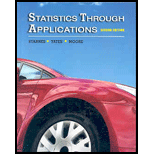
Concept explainers
(a)
To explain how we would assign labels and use random digits to choose the desired result.
(a)
Answer to Problem 5.68E
Explanation of Solution
FEMALES:
MALES:
(b)
To find out what is the chance that any one of the
(b)
Answer to Problem 5.68E
For males:
For females:
Explanation of Solution
For Males:
The probability is the number of favorable outcomes divided by the number of possible outcomes:
For Females:
The probability is the number of favorable outcomes divided by the number of possible outcomes:
(c)
To explain why the conclusion give in the question is wrong.
(c)
Explanation of Solution
The conclusion does not take into account the different opinions of males and females, while the opinions for females and males appear to differ a lot.
(d)
To find out what is the chance and explain why this sample is not SRS.
Answer to Problem 5.68E
For males and females:
Explanation of Solution
For Males:
The probability is the number of favorable outcomes divided by the number of possible outcomes:
For Females:
The probability is the number of favorable outcomes divided by the number of possible outcomes:
The systematic random sample is not a simple random sample because there are samples that cannot be selected, while there are samples that can be selected and thus all samples are not equally likely to be selected.
Chapter 5 Solutions
Statistics Through Applications
Additional Math Textbook Solutions
Introductory Statistics (2nd Edition)
Essentials of Statistics (6th Edition)
Statistics for Business and Economics (13th Edition)
Elementary Statistics: Picturing the World (7th Edition)
Basic Business Statistics, Student Value Edition (13th Edition)
 MATLAB: An Introduction with ApplicationsStatisticsISBN:9781119256830Author:Amos GilatPublisher:John Wiley & Sons Inc
MATLAB: An Introduction with ApplicationsStatisticsISBN:9781119256830Author:Amos GilatPublisher:John Wiley & Sons Inc Probability and Statistics for Engineering and th...StatisticsISBN:9781305251809Author:Jay L. DevorePublisher:Cengage Learning
Probability and Statistics for Engineering and th...StatisticsISBN:9781305251809Author:Jay L. DevorePublisher:Cengage Learning Statistics for The Behavioral Sciences (MindTap C...StatisticsISBN:9781305504912Author:Frederick J Gravetter, Larry B. WallnauPublisher:Cengage Learning
Statistics for The Behavioral Sciences (MindTap C...StatisticsISBN:9781305504912Author:Frederick J Gravetter, Larry B. WallnauPublisher:Cengage Learning Elementary Statistics: Picturing the World (7th E...StatisticsISBN:9780134683416Author:Ron Larson, Betsy FarberPublisher:PEARSON
Elementary Statistics: Picturing the World (7th E...StatisticsISBN:9780134683416Author:Ron Larson, Betsy FarberPublisher:PEARSON The Basic Practice of StatisticsStatisticsISBN:9781319042578Author:David S. Moore, William I. Notz, Michael A. FlignerPublisher:W. H. Freeman
The Basic Practice of StatisticsStatisticsISBN:9781319042578Author:David S. Moore, William I. Notz, Michael A. FlignerPublisher:W. H. Freeman Introduction to the Practice of StatisticsStatisticsISBN:9781319013387Author:David S. Moore, George P. McCabe, Bruce A. CraigPublisher:W. H. Freeman
Introduction to the Practice of StatisticsStatisticsISBN:9781319013387Author:David S. Moore, George P. McCabe, Bruce A. CraigPublisher:W. H. Freeman





